This blog post was recently updated on April 15, 2024.
Reboarding – the process of reintegrating employees into the workplace after a prolonged absence – requires careful planning and execution to ensure a smooth transition.
In this blog post, we will explore effective reboarding strategies that will help you support your returning employees and foster a positive work environment.
We’ll cover:
- Why reboarding is important
- When you should reboard employees
- How to get buy-in from leadership for your reboarding program
- How to tailor your reboarding program to your employees’ needs
- Reboarding mistakes to avoid
- Best practices to follow for a successful reboarding experience
- Measuring the success of your reboarding program
What is reboarding?
Reboarding is the process of reintegrating employees back into the workplace after an extended absence. It differs from onboarding, which focuses on integrating new hires into the company culture, policies, and work environment. Reboarding, on the other hand, is aimed at reacclimating existing employees to the workplace they are already familiar with, but that may have changed during their absence.
During the reboarding process, employees are provided with the necessary support, information, training, and resources to ensure a smooth transition back into their roles. It helps them brush up on their skills, catch up with any updates, and reconnect with their colleagues and the organizational culture they left behind.
Reboarding vs. Onboarding

While the goals of both reboarding and onboarding are similar – facilitating a smooth transition for employees – they differ in their focus and timing. Onboarding is typically conducted when new employees join the organization, providing them with the foundation necessary to thrive in their new role.
Reboarding, on the other hand, happens when existing employees return after an extended absence. It recognizes that these employees already have experience with the organization and its processes, but acknowledges the need to refresh their knowledge and reintegrate them into any changes that may have occurred during their time away.

When should companies reboard employees?
There are three main situations when reboarding is necessary:
After promotions or transfers
When an employee takes on a new role in the company, whether it's a promotion or lateral move, they should go through a condensed onboarding process again. This ensures they fully understand the new expectations, responsibilities, and cultural dynamics of their department or position. Provide training on new systems, introduce employees to new team members, and clearly communicate the goals of their role.
Upon return from leave
If an employee has been away on parental leave, long-term disability leave, or other extended absence, reboarding brings them back up to speed. Refresh them on any technological updates, new policies or projects, and changes in their role. Check in frequently when they first return to ensure their transition is smooth.
To reinforce company culture
Periodic reboarding, such as annually or biannually, can be used as an opportunity to realign employees with the company mission, values, and goals. Highlight accomplishments and wins since the last onboarding to showcase progress. Use it as a reset to boost engagement and productivity.
Why is reboarding important?
Reboarding provides a structured process to help employees readjust and feel comfortable, productive, and supported as they transition back to on-site work. It is especially important after long absences, such as extended leaves.
Benefits of reboarding for employees
Employees who have been away for an extended time can experience culture shock, feel out of the loop, or struggle to get up to speed. Reboarding helps mitigate these challenges.
The reboarding process reminds employees of the company mission, reconnects them with coworkers, and updates them on policy or workflow changes. This reestablishes connections and a sense of belonging.
Structured reboarding also provides training and coaching to help employees refresh old skills or learn new processes required by their role. This enables the employee to quickly regain full productivity.
Investing in reboarding improves employee retention, engagement, job satisfaction, and overall work quality. This ultimately benefits the entire organization.
Benefits of reboarding for the organization
Here are a few reasons why reboarding should be a top priority for businesses:
1. Reboarding enhances employee engagement
Employee engagement is a vital ingredient for a thriving workplace. When employees feel valued and supported, they are more likely to be engaged and committed to their work. Reboarding provides an opportunity for employers to reconnect with employees, reinforce their sense of belonging, and demonstrate their appreciation for their contributions. By investing in a comprehensive reboarding program, organizations can align employees' expectations and goals, fostering a deeper connection between individuals and the company's mission.
2. Reboarding boosts productivity
When employees return to work after an absence, whether it's due to a sabbatical, parental leave, or extended medical leave, they often face the challenge of reconnecting with their responsibilities and catching up on new developments within their roles. By implementing a structured reboarding process, companies can bridge this gap effectively, ensuring that returning employees receive the necessary support, training, and updates needed to perform at their best. A well-executed reboarding strategy can accelerate the ramp-up time, leading to a shorter productivity curve and higher individual and team performance.
3. Reboarding helps retain and attract top talent
Reboarding sends a powerful message to both current and potential employees - that the organization cares about their professional growth and development. This commitment to continuous support and investment in employees can significantly impact an organization's ability to attract and retain top talent. A positive reboarding experience demonstrates that the company values its employees as individuals and is willing to invest time and resources in their success. In the competitive landscape of talent acquisition, reboarding can be a critical differentiator to position the company as an employer of choice.
Getting buy-in from leadership to invest in reboarding
To successfully implement a reboarding program, obtaining buy-in from leadership and management is a crucial step in securing the necessary resources, time, and support.
Here are some strategies to help you gain their support:
1. Communicate the benefits: Clearly articulate the benefits of reboarding in terms that resonate with leadership, such as improved employee engagement, increased productivity, and better retention rates. Showcase success stories and share data that supports the positive impact of reboarding on business outcomes.
2. Explain the potential costs of not reboarding: Make leaders aware of the potential risks associated with not investing in reboarding, such as:
- decreased employee satisfaction
- reduced productivity
- increased turnover rates
Highlight the financial implications of losing valuable talent and the costs associated with replacing employees.
3. Present a well-defined plan: Create a comprehensive reboarding plan that outlines the necessary steps, timelines, and desired outcomes. Provide concrete examples of what the reboarding program would look like in practice and highlight the specific actions and resources needed from leadership.
4. Consider pilot programs: If leadership remains hesitant, consider proposing a pilot reboarding program to showcase the benefits firsthand. A successful pilot can help build confidence and garner broader support for a company-wide implementation.
5. Measure and communicate results: Once the reboarding program is in operation, consistently measure and communicate the outcomes and successes achieved. This allows leadership to see the tangible impact of their investment and provides an opportunity for continuous improvement.
Types of reboarding
Your approach to reboarding should never be a one-size-fits-all. There are different factors that influence what a reboarding process will look like. By recognizing these, you can ensure that you create a custom employee reboarding program that best suits your team members.
Reboarding factors to consider
#1 Reason for absence
Understanding the reason behind your employee's absence is vital in tailoring the reboarding experience. For instance, a planned sabbatical may have different emotional and physical implications compared to an absence caused by a sudden illness. By recognizing the unique aspects of each situation, you can provide the necessary support and resources to your team members.
#2 Duration of absence
The length of time an employee is away from the organization significantly impacts their reintegration. Longer absences tend to result in a more substantial disconnect with the work, team, and organizational culture. Reboarding programs designed for longer absences should focus on providing comprehensive updates on any changes that occurred during the employee's absence, refreshing their skills and knowledge, and rebuilding relationships with team members.
#3 Return capacity
Understanding your employee's readiness and capacity to return to work is critical when planning a reboarding program. Some employees may return full-time, while others may require a phased reintegration schedule. By accommodating their needs and preferences, you can ensure a smoother transition and help them adjust to work demands effectively.
How to design a customized reboarding program
Once you’ve considered the factors mentioned above, you can begin creating a tailored reboarding program. Here are some key steps to take:
🗣️ Communication
Open and transparent communication is essential throughout the reboarding process. Keep the returning employee updated about any changes, updates, or new projects that occurred during their absence. Schedule regular check-ins to address any concerns or questions they may have.
🎓 Training and development
Provide the necessary training or refresher courses to help your employees get up to speed with any changes in processes, technology, or industry trends. This will contribute to their sense of confidence and competence upon returning to work.
🤗 Team integration
Encourage social integration by organizing team-building activities or reintroduction sessions. This will help your returning employees reconnect with colleagues, rebuild relationships, and foster a sense of belonging.
🗓️ Flexible work arrangements
If possible, offer flexible work arrangements to accommodate your returning employee's needs. This can include modified work hours or work-from-home options during the initial phase of reboarding, helping them achieve a work-life balance and easing their transition.
🧑🤝🧑 Support and mentoring
Assign a mentor or buddy to your returning employees to provide additional support and guidance. This mentor should assist them with any questions, help them navigate any challenges, and ensure they feel valued and supported.
How to reboard your employees
To achieve best results with your reboarding initiative, it is crucial to have an effective process in place. Below, we highlight the 5 main steps to keep in mind when designing an effective reboarding program.

1. Demonstrate compassion and understanding
The first step in the reboarding process is to acknowledge the challenges and changes that employees may have experienced during their time away. Many employees have faced significant life changes and transitions, which can result in anxiety or stress.
As an employer, it is important to let your employees know that you understand and empathize with their situation. Send a message from leadership expressing this understanding and assure employees that resources will be provided to make the transition as smooth as possible.
2. Communicate changes in a positive way
When sharing recent changes to policies, guidelines, or operations, always frame them in a positive light. Highlight how these changes will improve efficiency or enhance the employee experience, rather than focusing on how they may alter workflows.
If roles have shifted during the employee’s time away, avoid assigning blame or making employees feel at fault. Instead, present this as an opportunity for employees to learn new skills and take on new challenges. Help employees see the positive aspects of these changes and how they can contribute to their growth in the organization.
3. Provide ample support and training
To ensure a successful reboarding, provide employees with the necessary support and training. There are a few ways you can do this:
- Make experts available to answer any questions or concerns that employees may have.
- Pair returning employees with those who remained on-site for peer training and mentoring.
- Schedule virtual or in-person training sessions to refresh skills and introduce employees to any new tools or systems that have been implemented.
- Create comprehensive guides, FAQs, and resources to explain the changes that have occurred during their absence.
You can use our Documents tool to add, manage, and share important files with your team. Essentially, this means you can set up your own intranet or knowledge base within Oneteam.
To start, head to the Oneteam web app and click on any existing Community. There, you’ll find the Documents button.
Once you click on it, you’ll be taken to a new screen where you can start creating your folders and uploading files.

When you create a new folder, you can set the permissions for it so that only specific Communities and/or Roles can view and open the folder.

Once you’ve created a new folder, simply click on it to start uploading your files. It’s as simple as that!
4. Clarify responsibilities and goals
As operations may have shifted, it is essential to clarify each employee's responsibilities, priorities, and goals upon their return.
Take the time to have individual meetings with each employee to realign expectations, ensuring that they are aware of how their roles contribute to company goals. Introduce any new metrics for success or progress and provide a space for employees to ask questions and become reacquainted with their workload.
This will help employees regain confidence and find stability within their roles.
5. Foster open spaces for discussion
Creating open spaces, both virtual and in-person, where employees can openly discuss their reboarding experience is vital. Host small group discussions or assign mentors who can serve as sounding boards for employees to share their challenges, concerns, and ideas during the transition.
Finally, regularly survey employees to gather feedback on their reboarding experience, as this will help identify any issues or opportunities for improvement.
The reboarding process
A successful reboarding process aims to ease employees back into the workplace rather than expecting them to immediately return to business as usual.
Here are some key aspects of the reboarding process to consider:
→ Stagger return of employees: When possible, avoid having all employees return on the same day or week. Create a staggered timeline for employees to transition back based on role, team, location, or other factors. This prevents overwhelming your systems and management.
→ Give teams time to adjust: Recognize that team members who have been away from work for longer periods of time will need time and space to adjust to in-person interactions and new work arrangements. Expect an adjustment period and provide extra support.
→ Allow flexible workloads and pace of return: Employees are returning from very different personal situations. Allow flexible hours, workloads, and pace of return to work based on individual needs. This will also help prevent burnout by not demanding too much too soon.
→ Arrange tours and team building: To reacclimate to the workplace, give returning employees tours highlighting new safety procedures and arrangements. Hold team building activities to improve collaboration and morale.
→ Schedule 1-on-1s to check in regularly: Frequent check-ins show you value your employees' wellbeing. Schedule 1-on-1 meetings to see how employees are adjusting and address any concerns early on. Be understanding and provide resources as needed.
Reboarding best practices
A successful reboarding program requires strong leadership, clear communication, and a strategic vision.
Let’s take a look at some of the best practices that can help ensure a smooth transition back to work and foster a positive and inclusive working environment.
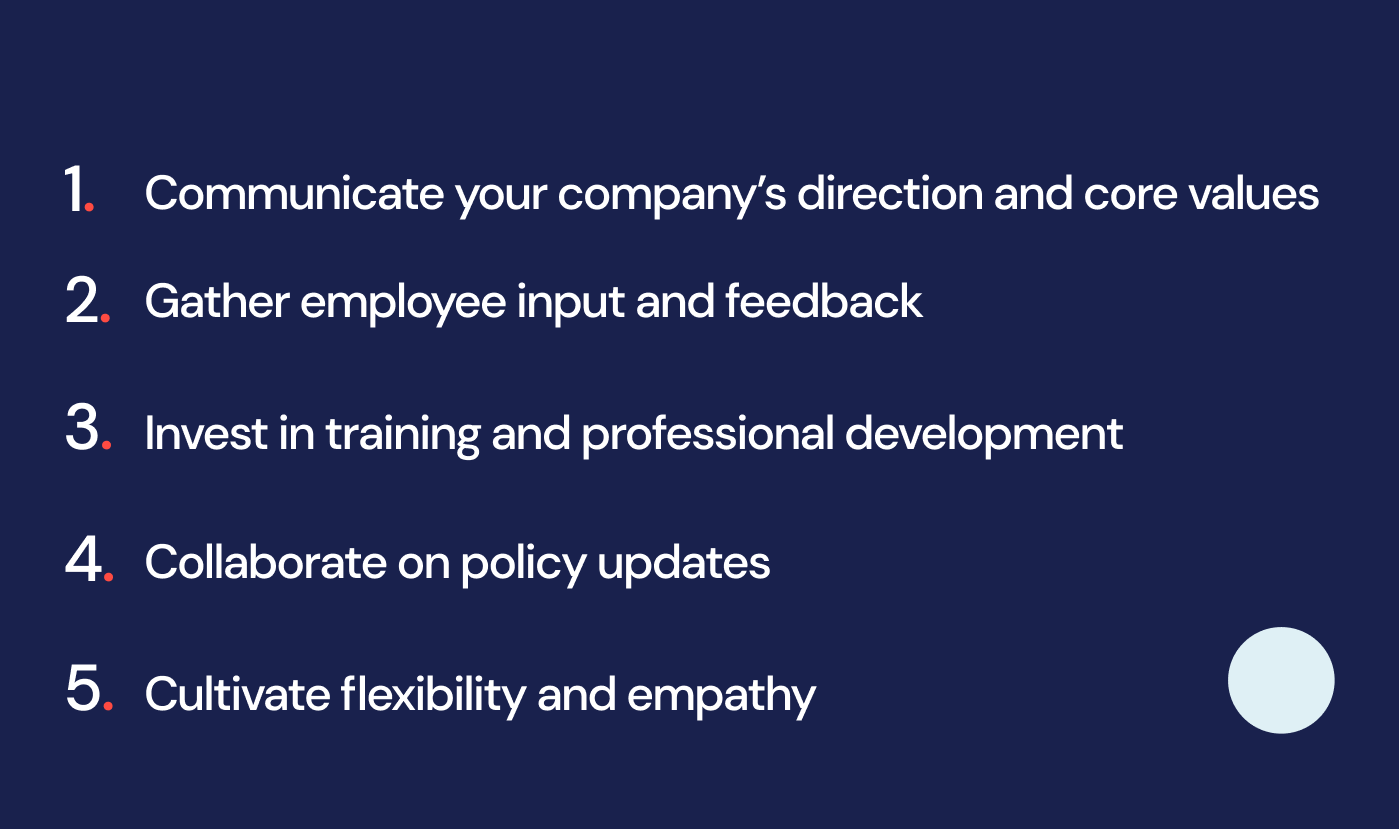
Communicate your company's direction and core values
During the reboarding process, it is crucial to communicate to employees your company's direction and priorities for the future. This means clearly articulating the organization's strategic vision and the role employees play in achieving it.
Provide reassurance by emphasizing core values that remain unchanged and highlighting the company's fundamental principles and mission. This helps create a sense of stability and purpose for returning employees.
Gather employee input and feedback
Listening to employee concerns and ideas for improvement is essential for a successful reboarding program. Conduct surveys, focus groups, and one-on-one meetings to gain a deeper understanding of individual needs.

With Oneteam, you can easily create and send surveys to your employees so you can quickly gather their feedback about the reboarding process.
To get started, click on Surveys and select if you want to start from scratch or use one of our pre-existing survey templates.

If you’ve selected one of our templates, you can fully customize it by:
- Adding components (such as images, video, and more) within the questions to make them more interactive and engaging
- Setting questions as optional or mandatory according to your survey goals
- Editing the text format in every module (bold, italicize, create headers, etc.)
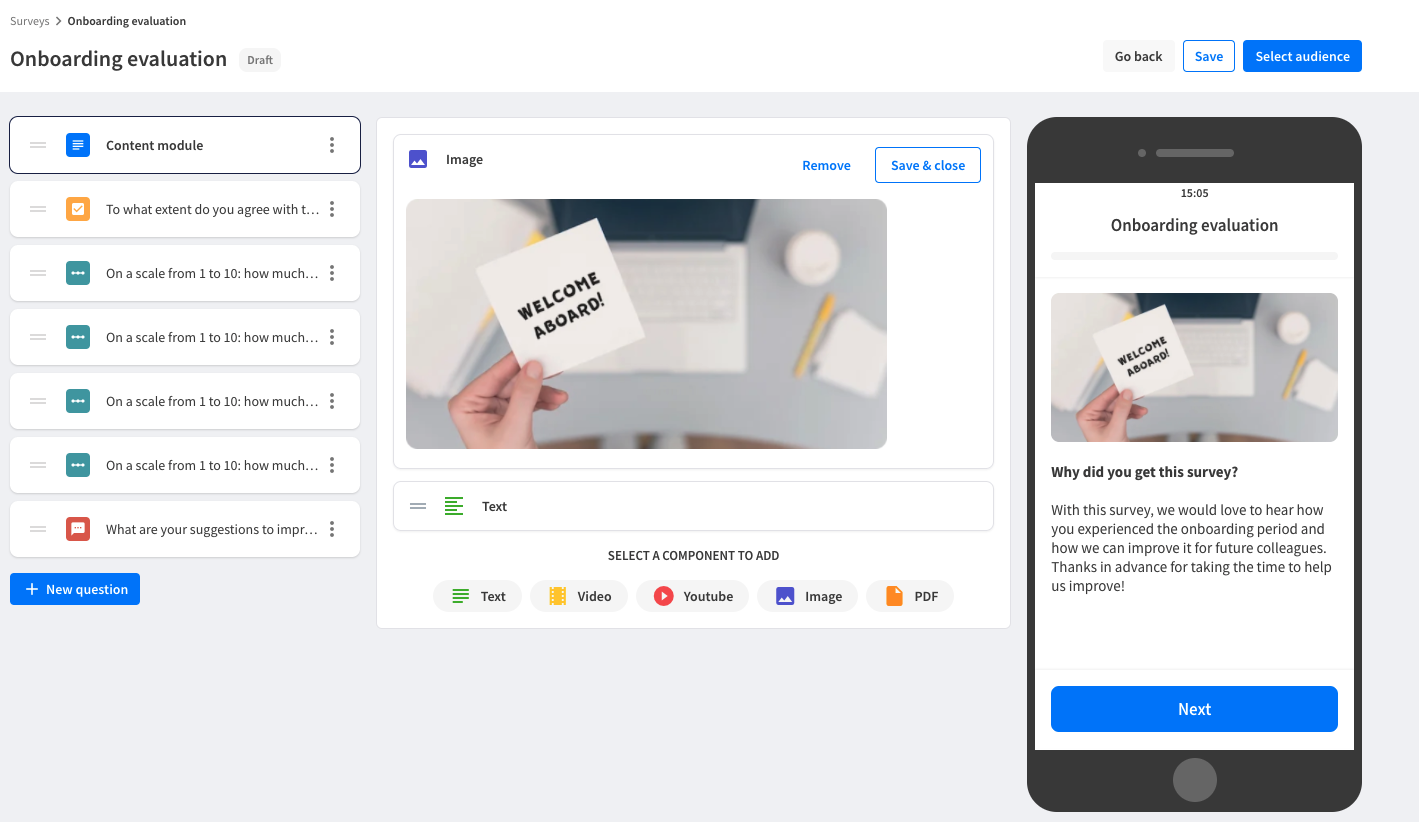
You can further customize your surveys by adding more questions. All you need to do is click on + New question. Your questions can be formatted as text answer, multiple choice, or slider. You can also add a content module with no question.
Once you’ve finished creating your survey, click on Select audience to filter who will receive this survey. You can filter your audience by name, language, days in service, Community, and Role).
Additionally, you can set a deadline for your survey. This will mean employees will receive multiple reminders to complete the survey.
It’s important to ensure that diverse voices are represented and that all employees feel their feedback is valued.
With Oneteam, once your employees have completed their survey you can quickly review their feedback by exporting all results as a .csv file.
Demonstrate how employee input helps shape new policies and procedures by implementing changes that directly address their feedback. This inclusivity and participatory approach can foster a sense of ownership and engagement among employees.
Invest in training and professional development
The reboarding process requires investing in training and professional development initiatives, particularly regarding new technologies, workflows, and safety policies.
For deskless teams, e-learning is the best way to deliver training due to its accessibility, flexibility, and ability to cater to diverse learning styles regardless of geographical location or time constraints.
With Oneteam, you can quickly create and deliver e-learning courses with our Academy.
To get started, navigate to Academy in the left menu, click on E-learning and then Add course.
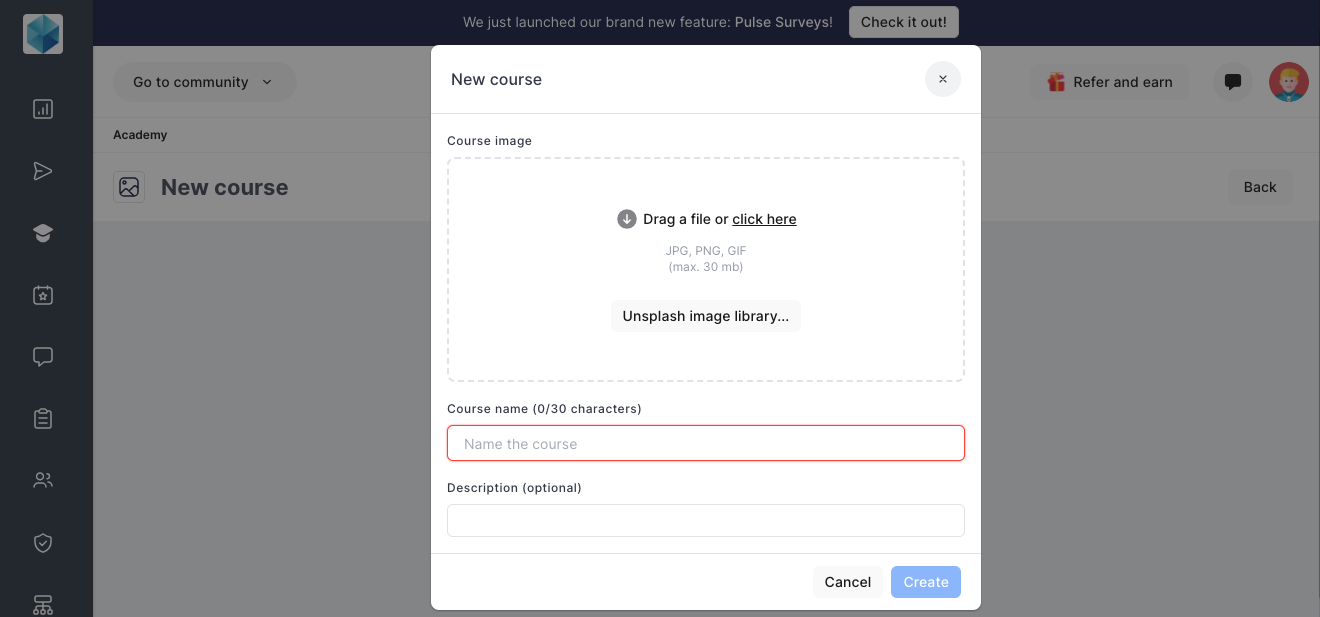
Give your e-learning course a name, a cover image and a description (optional) and click on Create.
Now, you can start adding in your course content by clicking on New module +.
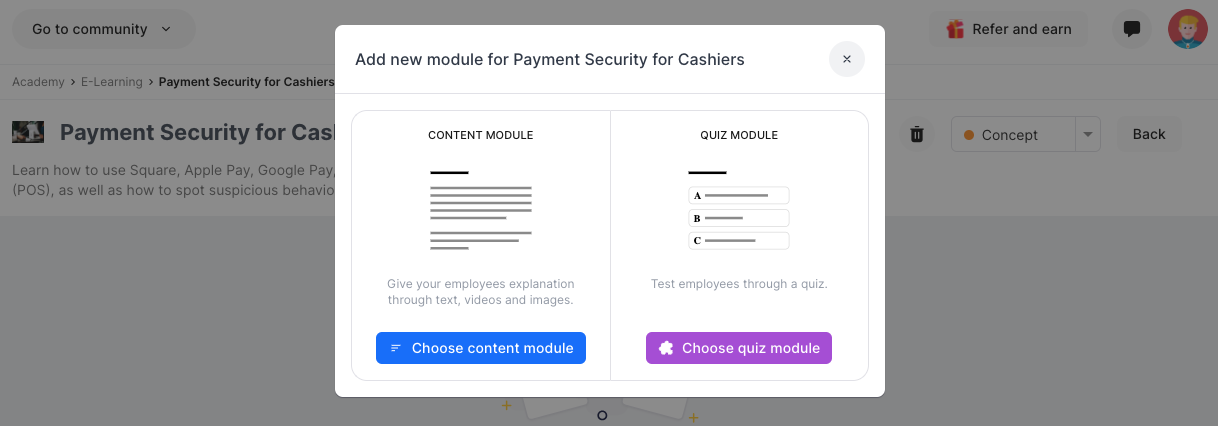
Every e-learning course is composed of multiple modules. When you want to create a new module, you’ll have the choice to create a Content Module (to provide information to your learners) or a Quiz Module (to test your learners on their knowledge).
For both types of modules, you can insert content in various formats including text, images, videos, PDF files, and YouTube videos.
Plus, as you create your content you’ll automatically get a preview of what your learners will see on mobile, allowing you to create a user-friendly learning experience from the get-go.
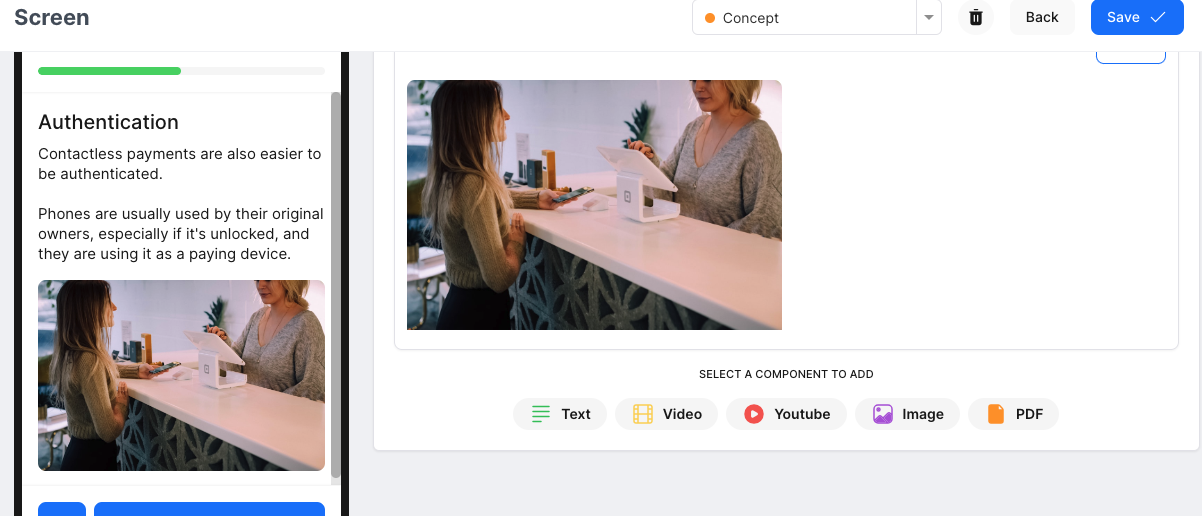
Once your course is ready, it’s time to assign it to your learners. Simply click on Everyone and apply your filters.
Using our example, let’s imagine we want to reboard the cashiers in our Amsterdam location since they have both just returned to their regular work location after an extensive renovation period. In this example, we’ve filtered our audience by Function > Cashiers and Community > Amsterdam.
Johan and Chantal will now receive a notification to complete this e-learning course to bring them up to speed about NFC payments.
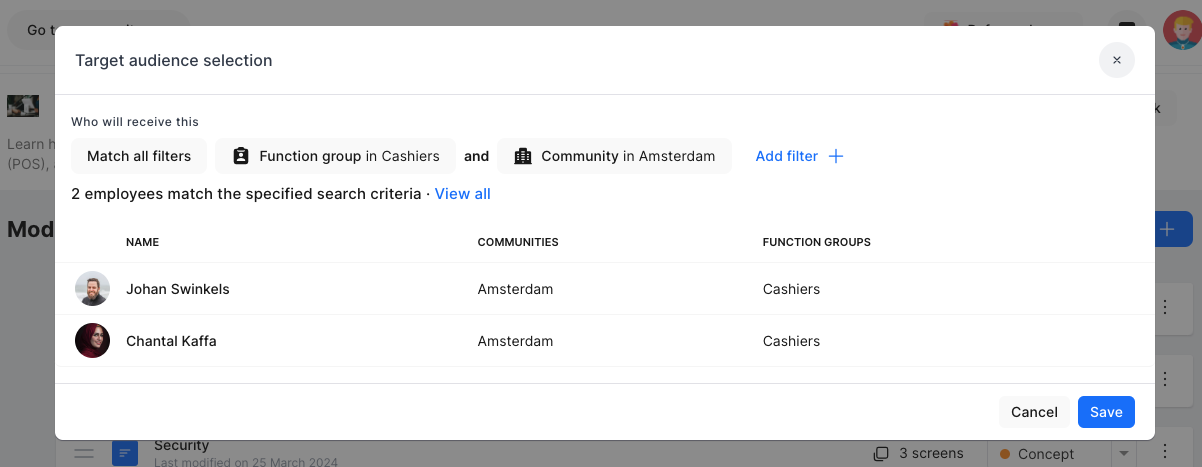
Lastly, it’s time to assign a deadline. To do so, simply on Deadline and choose one of two options:
- A static date and time in the future: This means all learners must complete the e-learning course by this pre-set date.
- A dynamic deadline: With this option, you can give your employees a specific set of time (starting from the moment you’ve assigned the course to them) to complete the course.

Once you’ve done a final check of your course, change it from Concept to Active. This will automatically publish your course and send out a notification to your employees, if you choose to enable that option.
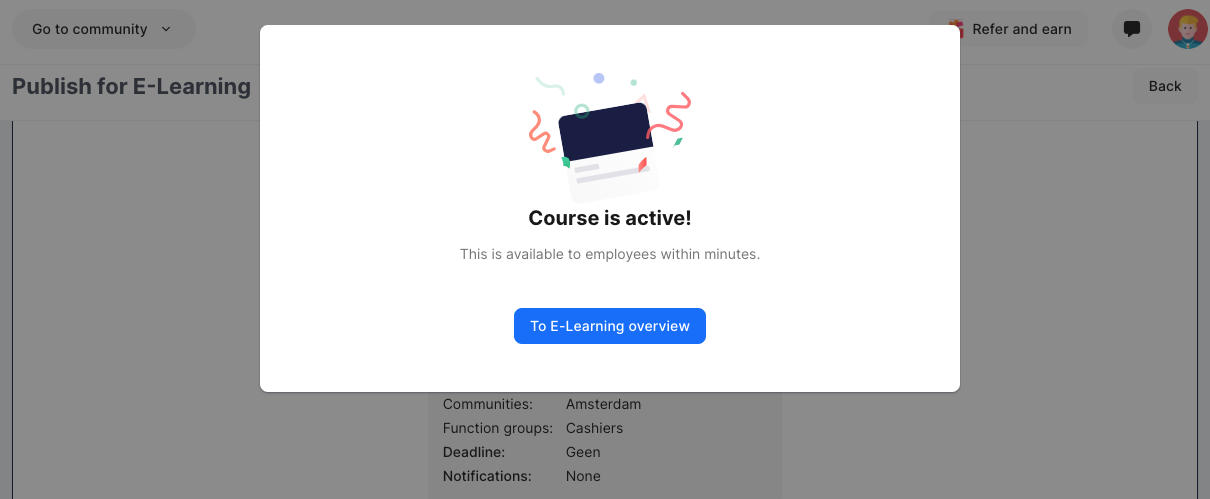
Here are some additional tips to start setting up your reboarding training and development:
- Allocate budget and resources to retrain employees across all roles and levels.
- Partner with experts to identify skills gaps and develop targeted training programs.
- Encourage participation by offering incentives and allowing time for learning during work hours.
By supporting employees in acquiring necessary new skills, you set them up for success and build their confidence in navigating the work environment upon their return.
Collaborate on policy updates
Working collaboratively with employees to update workplace policies is vital for an inclusive reboarding process.
Clearly communicate which policies remain in place and which ones are being revised. Explain the rationale behind these changes, taking into account employee circumstances and needs.
Ask for feedback and suggestions from employees to ensure that the revised policies reflect the diverse perspectives and requirements of your workforce. Regularly review and evaluate these policies to make adjustments if necessary, fostering a culture of continuous improvement.
One easy way to do this in Oneteam is with our Idea box template for Forms.

With this template, you can create a form to continuously collect feedback about your workplace policies.
Once you click on Idea box, you’ll be able to fully customize your form by editing the existing content and adding more modules.
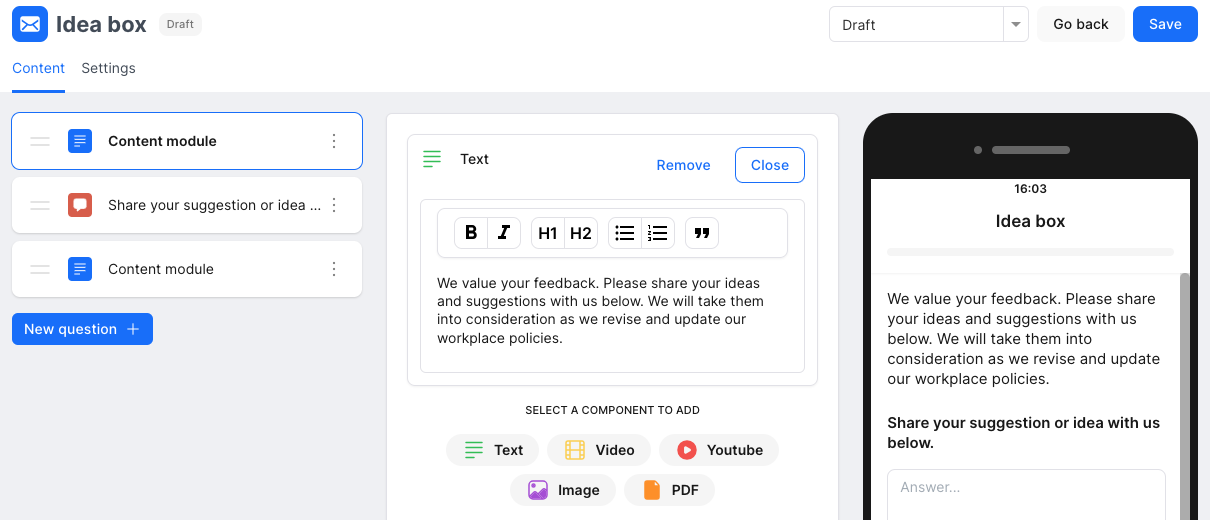
In the Settings tab, you can fully customize your form to add Form Moderators and filter which users can see and complete your Idea box form.
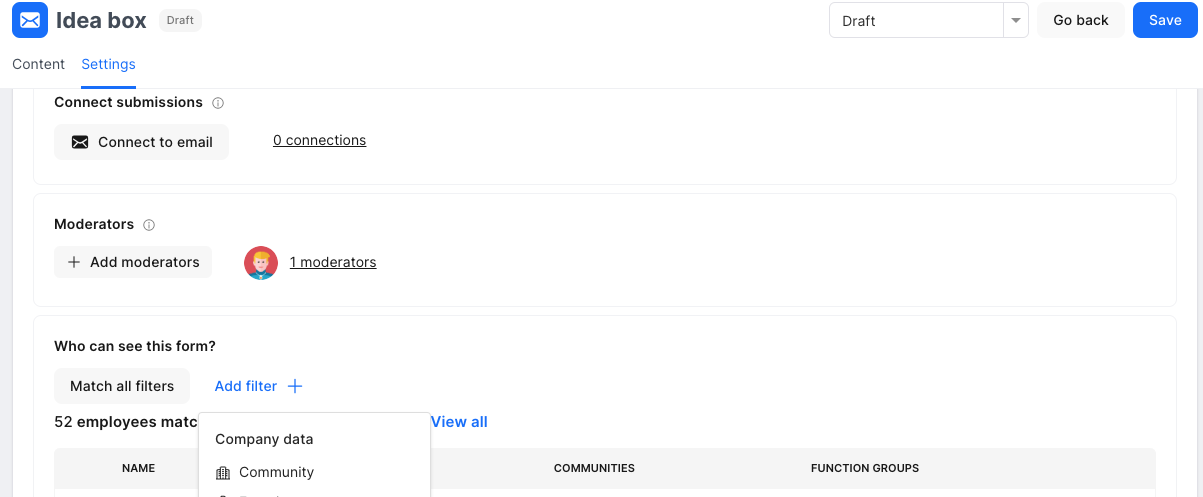
Cultivate flexibility and empathy
Flexibility and empathy should be championed as core cultural values during the reboarding process.
- Lead by example by supporting work-life balance and wellness.
- Accommodate the needs of working parents, caregivers, immunocompromised individuals, and any other employees with specific needs.
- Develop programs and policies that empower employees to manage their personal and professional lives effectively.
Foster openness, understanding, and compassion as you re-establish team cohesion, allowing employees to feel supported and valued in the workplace.
Avoid these reboarding mistakes
The reboarding process can easily go awry if not handled carefully. It's important to avoid some key pitfalls that could sabotage your reboarding efforts:
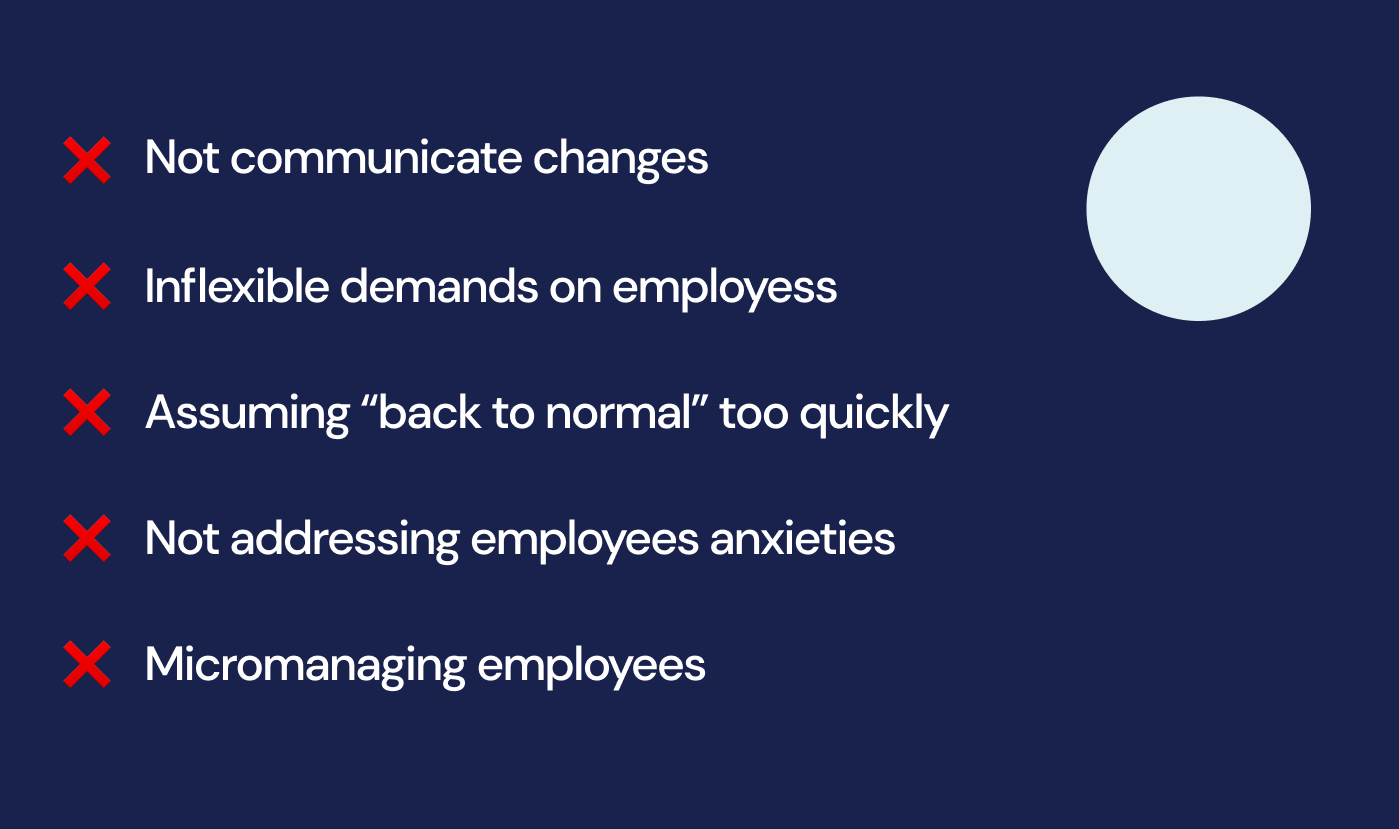
❌ Not communicating changes: Failing to keep employees informed about policy, procedure, or organizational changes that occurred while they were away can make them feel excluded, confused, and frustrated. Be transparent about all updates and provide resources to get re-acclimated.
❌ Inflexible demands on employees: Reboarding employees may need more flexibility as they adjust to being back in the workplace. Avoid rigid schedules, workloads, or demands that don't account for their transition needs.
❌ Assuming "back to normal" too quickly: Employees need time to find their groove again. Pushing them back into their old routines and expectations too fast can cause stress and performance issues. Ease them back in gradually.
❌ Not addressing employee anxieties: Many employees feel uncertain or anxious about returning to the workplace. Ignoring these concerns rather than discussing them openly can worsen morale issues. Create safe spaces for employees to share their reboarding challenges.
❌ Micromanaging employees: Let’s be honest – when is micromanaging ever a good idea? But closely monitoring tasks and imposing bureaucratic processes on employees as they reacclimatize can communicate distrust. Give space to rebuild skills and focus, and provide support when needed.
Avoiding these common missteps will lead to a smoother, more successful reboarding that engages and enables your employees. Fostering open communication, empathy and flexibility is key.
Measuring reboarding success
Reboarding initiatives should be regularly evaluated to determine if they are achieving the desired goals. There are several key metrics HR and leadership should track to measure the success of reboarding efforts:
- Employee satisfaction surveys: Conducting pulse surveys and gathering feedback is crucial. Look for improvements in engagement, satisfaction with communication, comfort with changes, and knowledge of new policies. Be sure to analyze results segmented by team, role, and demographic factors.
- Attrition rates: If reboarding is working, resignations should stabilize and regrettable turnover decrease. Monitor if certain teams or employee segments have greater retention challenges.
- Productivity metrics: Examine metrics like sales or output to see if productivity is rebounding. Watch for continued lags that may indicate reboarding issues.
- Participation in training and events: Employees embracing reboarding will attend trainings and participate in team events. Low attendance signals engagement challenges. Track participation rates.
- Uptake of remote/flex arrangements: If offering hybrid or flexible work options, monitor adoption rates. Healthy uptake indicates reboarding success and alignment between workforce needs and arrangements.
Continuously gathering this data will allow you to identify areas where more support may be needed during the reboarding process. Make adjustments and continue seeking feedback from reboarding employees.
Continuing the reboarding process
The reboarding process does not end once an employee has settled back into their role. It is important to continue checking in, providing refreshers, and fostering open communication.
Here’s a few ways to do that:
- Regular check-ins on adjustment: Managers should schedule recurring 1-on-1s to see how employees are adjusting to being back in the office or hybrid arrangements. Ask about what is working well and what can be improved. Be open to feedback.
- Refreshers on new policies and tools: Send out refreshers on any new policies, procedures, tools or systems. Offer quick training refreshers or support. Ensure employees know who to reach out to with questions.
- Ongoing training and team building: Training and team building should not be limited to the initial reboarding period. Look for opportunities for ongoing training, workshops, and team events. Investing in skill building and collaboration builds engagement.
- Updating workflows and responsibilities: As needs change, re-clarify workflows, processes, standards and individual responsibilities. Ensure roles and responsibilities align to business objectives.
- Maintaining open communication: Encourage employees to openly discuss what is and isn't working. Foster a culture where people feel safe surfacing concerns. Maintain open channels for providing feedback and voicing suggestions.
Key takeaways
Looking for a quick summary of our reboarding guide? Here’s everything you need to know:
- Reboarding is the process of reintegrating employees back into the workplace after an extended absence. It goes beyond just reorientation by proactively addressing changes that occurred while employees were away.
- The reboarding process should include clear communication, empathy, support resources, goal setting, and flexibility. Make sure to provide training, clarify responsibilities, foster team building, and regularly check in with employees.
- When done right, reboarding leads to higher engagement, productivity and retention. But mistakes like lack of direction, rigid demands, and assumptions can undermine the process. Use surveys, metrics and participation rates to track reboarding success.
- Reboarding is not a one-time event, but rather an ongoing adjustment period. Maintain open communication, refresh training, and update workflows to ensure a smooth employee transition. With the right reboarding strategy, companies can thrive despite disruptions.
Streamline your reboarding program with Oneteam
With a robust process and the right tools in place, you can create a reboarding program that allows your employees to ease back into work on the right foot.
Oneteam gives you a holistic employee experience solution to help you connect, train, and engage your deskless workforce at every moment of the employee experience.
This includes:
- E-learning for creating and delivering engaging training programs so you can bring your employees up to speed on the go
- Surveys to learn what’s working and gain actionable insights on how you can further improve your reboarding process
- Events to easily schedule and plan events for all or a selected group of employees during the reboarding process




